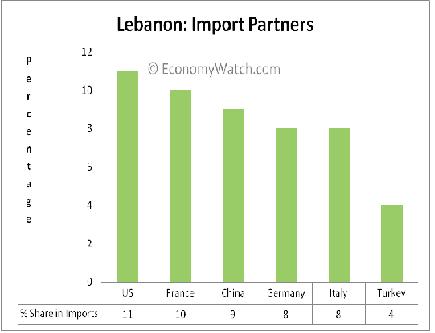Lebanon Trade, Lebanon Exports, Lebanon Imports
Please note that we are not authorised to provide any investment advice. The content on this page is for information purposes only.
Table of Contents
Lebanon Trade: Exports
Wars with Israel, sectarian clashes and political instability have kept the manufacturing segment weak and less productive.
Lebanon Trade: Exports
Wars with Israel, sectarian clashes and political instability have kept the manufacturing segment weak and less productive. Exports have therefore been very low compared to the country’s growing imports. Exports are currently pegged at $5.113 billion.
The main exported commodities are jewelry, base metals, chemicals, miscellaneous consumer goods, fruit and vegetables, tobacco, construction minerals, electric power machinery and switchgear, textile fibers and paper.
It is well known for agricultural produce, particularly citrus, grapes, tomatoes, apples, vegetables, potatoes, olives, tobacco; sheep and goats. The agricultural heart of the country is the fertile Bekaa Valley.
Lebanon’s primary export partners are: Syria (24.9% of exports), UAE (12.9%), Switzerland (6.6%), Saudi Arabia (6.1%) and Turkey (4.2%).
Lebanon Trade: Imports
Lebanon imports have always been an area of uncertainty for the country’s economy, since the country has limited to no domestic capability in crucial areas such as energy, food and other commodities, as well as electronics and cars.
Lebanese import around three times more than they export, importing goods and services worth $15.78 billion currently, thanks to a combination of limited manufacturing capability, uncertainty hampering forward planning, and a lack of resources.
The main commodities that Lebanon imports are petroleum products, cars, medicinal products, clothing, meat and live animals, consumer goods, paper, textile fabrics, tobacco, electrical machinery and equipment, chemicals
Lebanon’s main imports partners are Syria (10.5% of imports), France (9.5%), US (9.3%), Italy (7.3%), China (6.8%), Germany (4.9%), Saudi Arabia (4.8%) and Turkey (4.2%).

Lebanon’s industrial growth rate is currently estimated at 2%.




